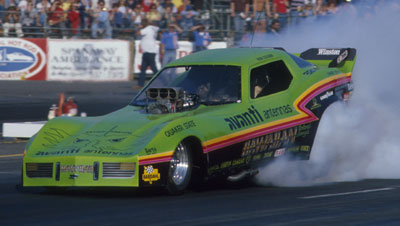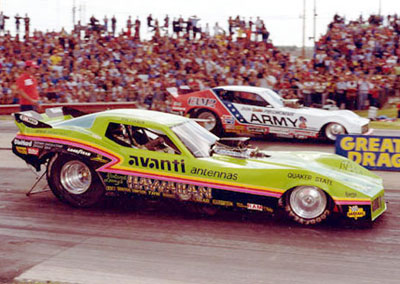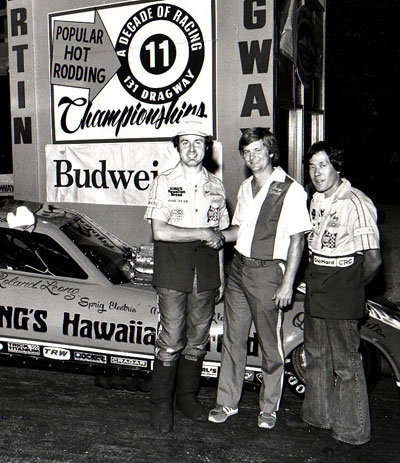

Friday the 13th special: the Corvette Curse and other superstitions
 |
Well, race fans, here it is, the day that’s more taxing to some people than April 15. That’s right, look at the calendar or at the date above. It’s Friday the 13th. Ooooh.
Believe it or not – and have I ever lied to you? – there’s even a name for the fear of this day: paraskevidekatriaphobia. It’s the big brother to that most famous of fears, triskaidekaphobia, which is the fear of the number 13 appearing in any case.
So, I find it wholly appropriate on this scary day of the year (the only one in 2008, mind you, but beware 2009, which will host three, in February, March, and November) to talk about bad luck and, in particular, drag racing’s once-dreaded Corvette Curse.
I mentioned the topic of bad luck briefly in my article last week about Jim Green, including the superstitions about green, peanuts, and women in the pits (which drag racing historian Jim Hill addresses later in this column), which prompted reader David Hapgood to wonder how then could it be that any car that had two superstitious strikes against it ever survived. He was talking about, of course, the car pictured above, the Roland Leong-owned, Ron Colson-driven, Avanti Antennas-sponsored Corvette that was painted a bright, bright, BRIGHT shade of green.

(Above) The Beach City Corvette meets its end. (Below) Tom McEwen's '77 Corvette; note the short rear deck and lack of side spill plates.
|
 |
To backtrack a bit, Corvette-bodied Funny Cars got a really nasty reputation in the late 1960s and early 1970s when many of them met a fiery demise -- Glenn Solarno’s Invader, which came to fame with "Mighty Mike" Van Sant at the wheel, burned to the ground at Bryon Dragway with Gary Scow at the controls, and Bob Harris’ Super Shaker Corvette met a similar fate at Houston Int'l Dragway -- but, in retrospect, given the number of cars that were torched in those experimental years, most of it probably could be chalked up to coincidence. The exception, of course, was Don Kirby’s infamous Beach City Corvette, which crashed many times before it met its glorious and fiery finale in 1970, when shoe Ron Goodsell rode it off the end of the track at Orange County Int’l Raceway and out onto the freeway, where it burned to the ground.
Later, the Corvette name got even more black eyes because its chick-magnet design proved poorly suited to drag racing, and many Corvette-bodied floppers of the mid-1970s were ill-handling, wicked rides that were as likely to visit Mr. Guardrail as they were the winner’s circle.
Not all Corvette drivers experienced woes, but it took the wily “Mongoose,” Tom McEwen, to put an end to the curse. In 1976, he finished a distant 15th in the points battle, but it was still the highest that any driver of a Corvette-bodied car had ever finished, yet he knew he needed more help.
“The cars were evil,” he told me in a 2001 interview. “At about 900 to 1,000 feet, they’d just make a left-hand turn. Most of them crashed. I know I almost did. The car had a short little rear deck, and at top speed, the air would come off the spoiler, and the back of the car would lift off the ground.”
Fortunately for the well-liked ‘Goose, he had friends in the Indy-car world who in 1978 turned him on to the concept of adding side spill plates to the rear-deck spoiler to trap the air. Later that year, he won the U.S. Nationals in his English Leather Corvette, defeating longtime friend and rival Don “the Snake” Prudhomme in an emotional victory that followed by two weeks the death of his 14-year-old son, Jamie, who passed away after a three-year battle with leukemia.
 |
But back to the green Corvette.
I tracked down our old buddy Ron Colson, a veteran of the front-engine Top Fuel wars and once a top-ranked Funny Car pilot. Colson worked at Avanti in the late 1970s and talked the company into backing their racing efforts. (Remember this was the ’70s, when CB radios could be found in cars and homes everywhere, 10-4? We had an Avanti Astroplane antenna strapped to the side of our house on a 30-foot triangular tower that my stepfather had welded together in our backyard.)
The only hitch for Leong and Colson? The color.
“We had to use chartreuse and black because company president John Martino had picked them as Avanti's company colors for the highest visibility and the highest contrast,” recalls Colson. “Roland and I were thinking the car was going to be butt ugly, but what racer can say no to a sponsor? We went to [famed race car painter Tom] Stratton to paint the car, and he said, ‘No problem. We'll just separate the two colors with stripes of orange and hot pink and yellow.’ Roland and I are both thinking, ‘Gag me with a spoon,’ but that is why Stratton was an artist and Roland and I were racers! It looked great!”
The team's Monza was the first car to get the green scheme, and it lived up to the green superstition in spades. “That car was a tire-shaking SOB, and it nearly knocked me out on every pass down the track,” Colson recalls. “In qualifying at Indy, it made one pass without shaking and ran a 6.08, a respectable run in 1978. In eliminations, probably as a result of all that tire shake, the rear end started to tear out of the mounts, and I crossed the centerline on a single. That run was shown thousands of times in Decade of Thrills. Unfortunately, I never got to go on TV and say, ‘Hey guys, of the four mounting tubes, one broke in two, one collapsed, and two were distorted.’ ”
By this time, the Corvette bodies were more or less sorted out, and the team got a Corvette shell and had Jaime Sarte build a new beefier chassis. While Colson remembers the ’78 Monza as probably the worst race car he ever drove (despite carrying him to the winner’s circle at the 1978 Fallnationals), he thinks that the green '79 Corvette was probably the best ever. They finished the season fifth in points that year.
|
|
They kicked off an amazing 1980 with a Dodge Charger body, with sponsorship from King's Hawaiian Bread, and a new burnt-orange paint scheme and were runner-up to Dale Pulde at the Winternationals, but the Corvette was not out of the picture long.
In Englishtown, Colson recalls, “the windshield posts snapped in the lights (we didn't use side windows then), and the roof came down and pinned my hands on the wheel. Obviously, I couldn't see at all, but after years in a front-engine fueler, I was used to that. I did get my right hand free, and I could get to the brake lever at about the middle, which translates to half braking leverage. Fortunately, as the lower half of the body was exploding (we gathered up 218 pieces, but not enough to put the puzzle back together), the chutes deployed from the disintegration. One tangled, and one, fortunately, opened. When the Safety Safari guys lifted the roof off of me, I could see that I was within 100 feet of going off the end of the track.”
With a full slate of match races still ahead, Leong flew two crewmembers home to Los Angeles to bring the Corvette body to Chicago in a rental truck, and Hank Buk painted the orange and black King's Hawaiian colors over the Avanti green. The team went on to win the prestigious Popular Hot Rodding meet and the NHRA World Finals, the last drag race held at Ontario Motor Speedway, with a victory that sealed a career-best third-place finish for the team.
The Corvette Curse seemingly was over in 1980, though there are those who say it merely transferred to the similar-looking Datsun 280ZXs, most of which also met early ends. Tim Grose, of course, plowed his into the guardrail in Columbus in 1980, John Collins’ Pioneer Audio Express tangled with the guardrail in Bakersfield that same year, and Gary Densham’s Teacher's Pet met a fiery end at the 1981 World Finals at OCIR. Alcohol racers such as Vern Moats, however, had much greater success with the design; Moats’ Hamms-sponsored machine was a top runner for years and even carded the first 6.3-second alcohol run at Fremont in 1983.
![]()
Certainly the above weren’t the only superstitions and curses to infiltrate the sport. One of the most prevalent lately is the No. 1 qualifier's jinx, as so few nitro racers have won from the top spot over the past two years.
Some drivers today still insist on putting on their safety gear in a predetermined pattern – which glove goes on first, etc. – though some will say that’s more to develop a routine so nothing is forgotten.
I also remember in Jim Kelly’s interview in Drag Racing USA with “T.V. Tommy” Ivo after Ivo's big Pomona crash in 1974 that Ivo related that not only had he caught one of his crewmembers eating peanuts in their pit the day before, but, on the day of the crash, he also had forgotten to wear his good-luck Egyptian ankh (the key-of-life symbol once carried by Pharaohs). More currently, it's pretty well-known that John Force won't climb into his Castrol Mustang without at least one St. Christopher medal (and sometimes two) around his neck, and images of the medal, saluting the Catholic patron saint of travellers, also have adorned his race car.
For a long time, drivers made sure that they climbed into the cockpit from the same side all the time, and Ivo was among them. He used to enter the car exclusively from the right side until a massive clutch explosion in Indy in 1967, and after that, only from the left side. After the Pomona crash, he mused that perhaps he’d next have to crawl over the engine to get in.
Racers also have claimed superstitions about who belts them in, tucking a found heads-up penny in their fire boots, or carrying different mascots with them (witness "Hot Rod" Fuller's battle-scarred troll).
And, of course, let’s not forget about Joe Amato’s lucky Snoopy underwear. Amato always swore that crew chief Tim Richards was the most superstitious guy on their team, which makes you wonder why it was okay for Amato to have Snoopy as a mascot on his shorts and on the car; after all, he was a character in a comic strip called Peanuts ...


Okay, here's what I figure is pretty much the worst-case scenario: a green female peanut M&M. I reckon you won't find her in many pit areas.
|
I got a few e-mails asking about the origin of the green/peanuts/women in the pits superstitions. They all pre-date me, so I turned to the voice of experience. The name Jim Hill might not be familiar to some of you, but in our world, he’s one of the most respected historians of the sport. He’s been around long enough to have seen and known Don Garlits while his fame was still largely in Florida, wrote for many drag racing publications in the 1960s, had a nice career in advertising and marketing at Crane Cams (he helped establish the Crane Cams 250-mph Funny Car Club), and was a member of the handpicked panel that helped determine NHRA’s Top 50 racers in 2001.
“When I was a youngster growing up in Hialeah, Fla., there were two types of racing action to check out,” he wrote. “One was drag racing at Amelia Earhart Airfield, in Hialeah, and the other was circle track racing at Palmetto Speedway, just across the Miami River Canal, near Hialeah.
“The superstitions you mention began with the circle-track folks. Green cars were ‘bad luck’ because way back someone driving a green car had been killed in it. Eating peanuts in the pits and dropping the shells was also bad luck because -- again -- way back someone had been killed after someone else had been eating peanuts and dropping shells around his pit. (Do you see a pattern of lunacy developing here?) [Phil note: Bruce Larson once told ND that peanuts were considered bad luck because the discarded shells were capable of being sucked into engines.]
"Another widespread circle-track superstition was never having a car number that could be read upside down. That one is obvious, especially if the racer in question had a number that could be read upside down and while on fire.
“Another was: ‘Any woman in the pits is bad luck.’ This came from a way-back instance where some racer was distracted by a woman in the pits, probably because she was wearing something tight, low-cut, and provocative, and he left all the lug nuts loose, the car lost a wheel, and he crashed and got himself killed.
“Many of the circle tracks I went to in the ‘50s and ‘60s prohibited women from entering the pits, peanuts were never seen in the pits, upside-down legible numbers were never applied for, and up until Harry Gant won a bunch of NASCAR Grand National (later Winston Cup, now Sprint Cup) races in his green Skoal Bandit, you never painted a race car green.”
Okay, so that’s your Friday the 13th fill of curses and superstitions. Just be careful that when you avoid that black cat crossing your path you don’t walk under that ladder or step on a crack.




















































